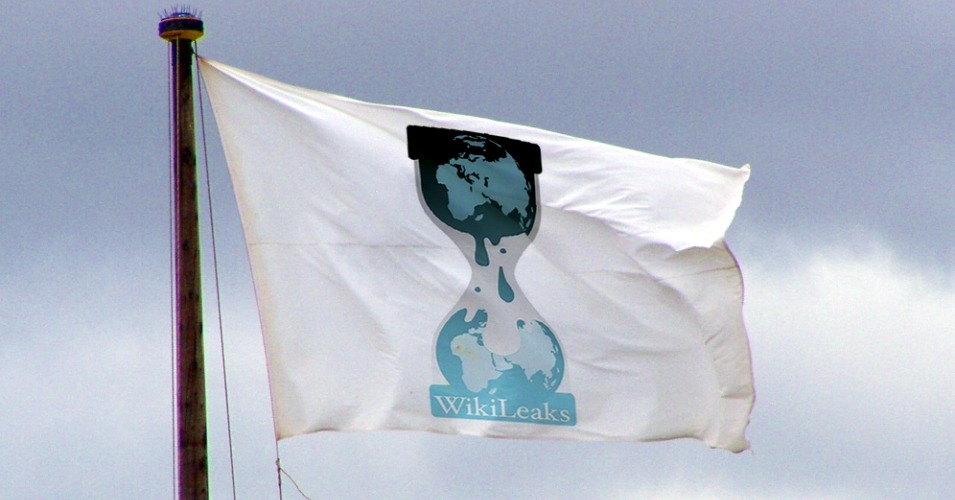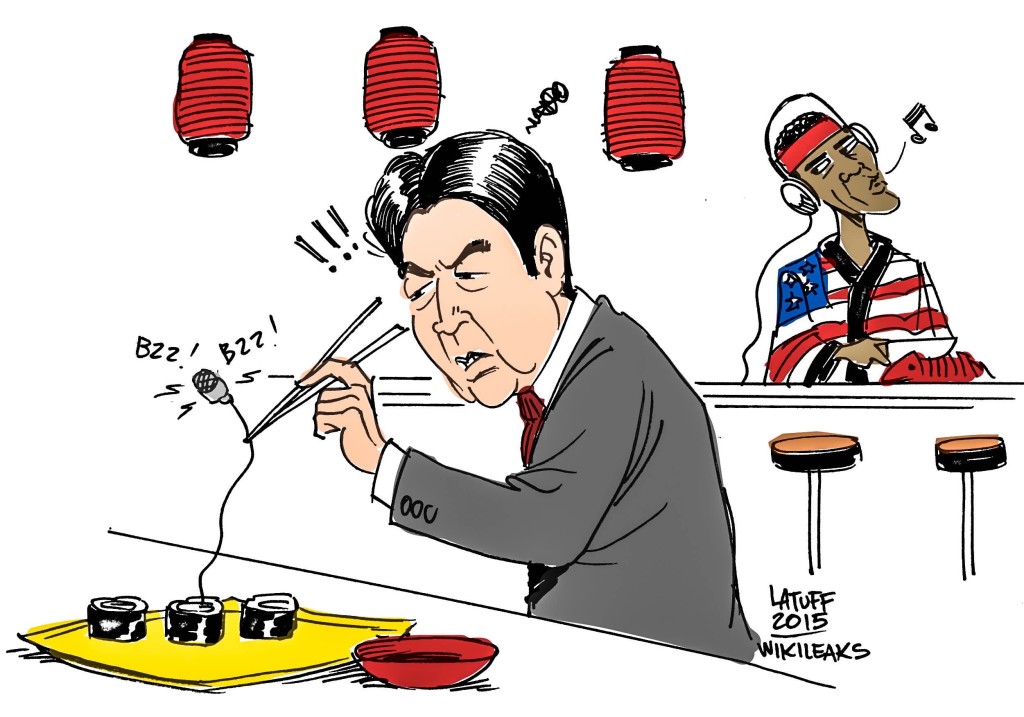Target Tokyo: US Spied on Japanese Government and Corporations Since 2006
WHISTLEBLOWING - SURVEILLANCE, 3 Aug 2015
WikiLeaks – TRANSCEND Media Service
Today, Friday 31 July 2015, 9am CEST, WikiLeaks publishes “Target Tokyo”, 35 Top Secret NSA targets in Japan including the Japanese cabinet and Japanese companies such as Mitsubishi, together with intercepts relating to US-Japan relations, trade negotiations and sensitive climate change strategy.
The list indicates that NSA spying on Japanese conglomerates, government officials, ministries and senior advisers extends back at least as far as the first administration of Prime Minister Shinzo Abe, which lasted from September 2006 until September 2007. The telephone interception target list includes the switchboard for the Japanese Cabinet Office; the executive secretary to the Chief Cabinet Secretary Yoshihide Suga; a line described as “Government VIP Line”; numerous officials within the Japanese Central Bank, including Governor Haruhiko Kuroda; the home phone number of at least one Central Bank official; numerous numbers within the Japanese Finance Ministry; the Japanese Minister for Economy, Trade and Industry Yoichi Miyazawa; the Natural Gas Division of Mitsubishi; and the Petroleum Division of Mitsui.
Today’s publication also contains NSA reports from intercepts of senior Japanese government officials. Four of the reports are classified TOP SECRET. One of the reports is marked “REL TO USA, AUS, CAN, GBR, NZL”, meaning it has been formally authorised to be released to the United States’ “Five Eyes” intelligence partners: Australia, Canada, Great Britain and New Zealand.
The reports demonstrate the depth of US surveillance of the Japanese government, indicating that intelligence was gathered and processed from numerous Japanese government ministries and offices. The documents demonstrate intimate knowledge of internal Japanese deliberations on such issues as: agricultural imports and trade disputes; negotiating positions in the Doha Round of the World Trade Organization; Japanese technical development plans, climate change policy, nuclear and energy policy and carbon emissions schemes; correspondence with international bodies such as the International Energy Agency (IEA); strategy planning and draft talking points memoranda concerning the management of diplomatic relations with the United States and the European Union; and the content of a confidential Prime Ministerial briefing that took place at Shinzo Abe’s official residence.
Julian Assange, WikiLeaks Editor-in-Chief, said: “In these documents we see the Japanese government worrying in private about how much or how little to tell the United States, in order to prevent undermining of its climate change proposal or its diplomatic relationship. And yet we now know that the United States heard everything and read everything, and was passing around the deliberations of Japanese leadership to Australia, Canada, New Zealand and the UK. The lesson for Japan is this: do not expect a global surveillance superpower to act with honour or respect. There is only one rule: there are no rules.”
WikiLeaks Investigations Editor Sarah Harrison said: “Today’s publication shows us that the US government targeted sensitive Japanese industry and climate change policy. Would the effectiveness of Japan’s industry and climate change proposals be different today if its communications had been protected?”
Japan has been a close historical ally of the United States since the end of World War II. During a recent Presidential visit to Japan, US President Barack Obama described the East Asian country as “one of America’s closest allies in the world”. Today’s publication adds to previous WikiLeaks publications showing systematic mass spying conducted by US intelligence against the US-allied governments of Brazil “Bugging Brazil”, France “Espionnage Élysée” and Germany “The Euro Intercepts”; “All the Chancellor’s Men”.
Read the full list of NSA high priority targets for Japan published today here.
___________________________________
WikiLeaks’ journalism is entirely supported by the general public. If you would like to support more work like this, please visit https://wikileaks.org/donate.
Go to Original – wikileaks.org
DISCLAIMER: The statements, views and opinions expressed in pieces republished here are solely those of the authors and do not necessarily represent those of TMS. In accordance with title 17 U.S.C. section 107, this material is distributed without profit to those who have expressed a prior interest in receiving the included information for research and educational purposes. TMS has no affiliation whatsoever with the originator of this article nor is TMS endorsed or sponsored by the originator. “GO TO ORIGINAL” links are provided as a convenience to our readers and allow for verification of authenticity. However, as originating pages are often updated by their originating host sites, the versions posted may not match the versions our readers view when clicking the “GO TO ORIGINAL” links. This site contains copyrighted material the use of which has not always been specifically authorized by the copyright owner. We are making such material available in our efforts to advance understanding of environmental, political, human rights, economic, democracy, scientific, and social justice issues, etc. We believe this constitutes a ‘fair use’ of any such copyrighted material as provided for in section 107 of the US Copyright Law. In accordance with Title 17 U.S.C. Section 107, the material on this site is distributed without profit to those who have expressed a prior interest in receiving the included information for research and educational purposes. For more information go to: http://www.law.cornell.edu/uscode/17/107.shtml. If you wish to use copyrighted material from this site for purposes of your own that go beyond ‘fair use’, you must obtain permission from the copyright owner.
One Response to “Target Tokyo: US Spied on Japanese Government and Corporations Since 2006”
Read more
Click here to go to the current weekly digest or pick another article:
WHISTLEBLOWING - SURVEILLANCE:


Virtually no American officials need their passports when they visit and stay in Japan. First, they can fly from the United States to one of the US military airbases in Japan. For example, they can fly to the Yokota airbase from the United States. Second, they can fly from the US airbase such as from Yokota to the US heliport near the US Embassy in Tokyo. It takes only five minutes by car from the US heliport to the US Embassy. Then, the US Embassy arranges everything necessary for the US official directly from the United States. Third, the US official is to be aware that it takes only five or ten minutes by car to reach the areas in which the main offices of the Japanese government and those of major Japanese companies are located. Because of that, the Japanese government admit that they have no idea which US officials and how many US officials are staying in Japan now. Spying? Who needs spying? For the US officials, everything is virtually open as such.
That is how SOFA (= “Status Of Force Agreement” between the United States and Japan) enables the US officials to do so. Taro Terasaki, a prominent Japanese diplomat who dealt with relevant issues of AMPO (= Treaty of Mutual Cooperation and Security between the United States and Japan), once said, “At a glance, it looks like that SOFA is only a supplementary instrument to AMPO. But the truth is that AMPO is for SOFA; not SOFA is for AMPO.” Many people discuss AMPO, but only a handful of people are aware of the vital importance of SOFA, an essential instrument for the US foreign policy in the Far East. (One of the main political figures regarding the initiation and/or preparation of the political arrangements/design as mentioned above may be attributed to John Foster Dulles, served as the Secretary of State from 1953 – 1959. History goes on.)